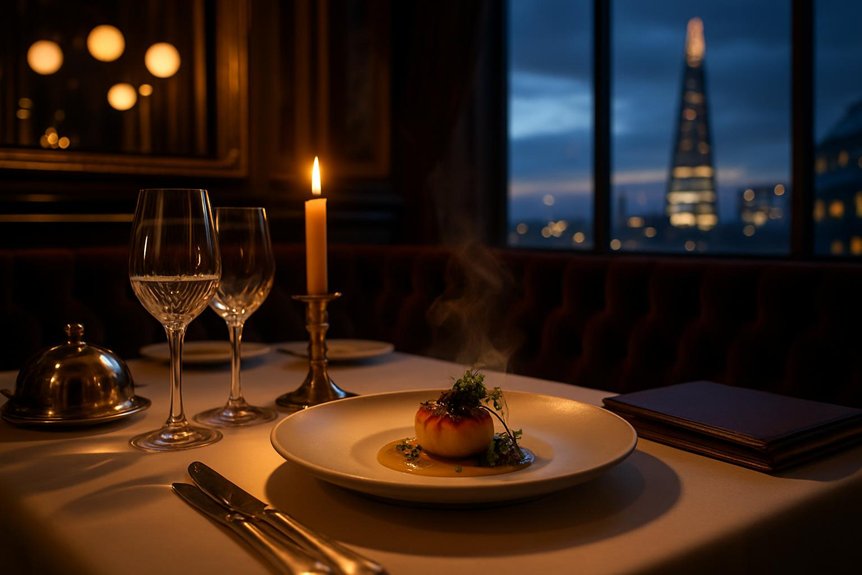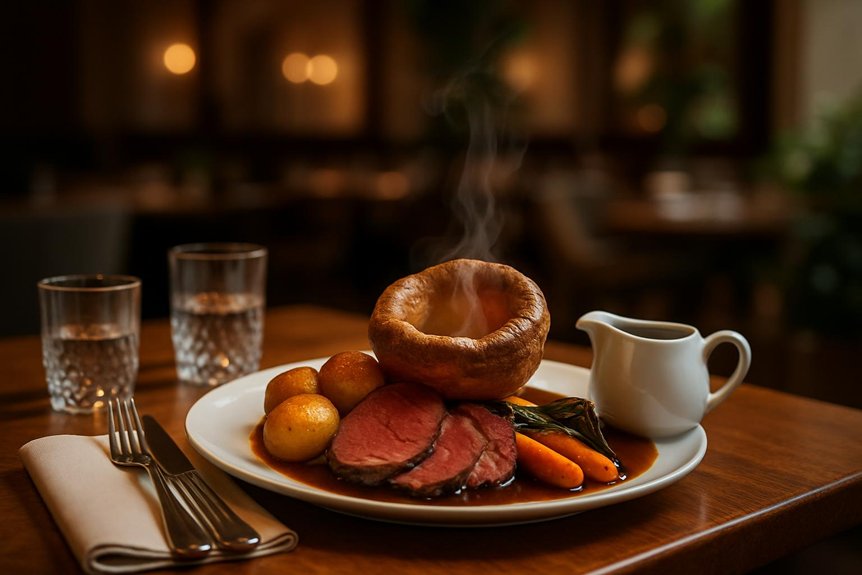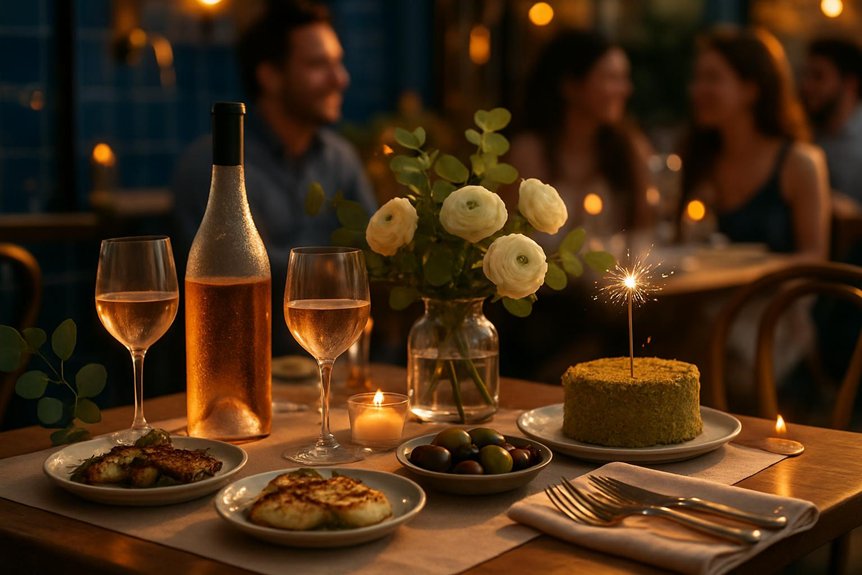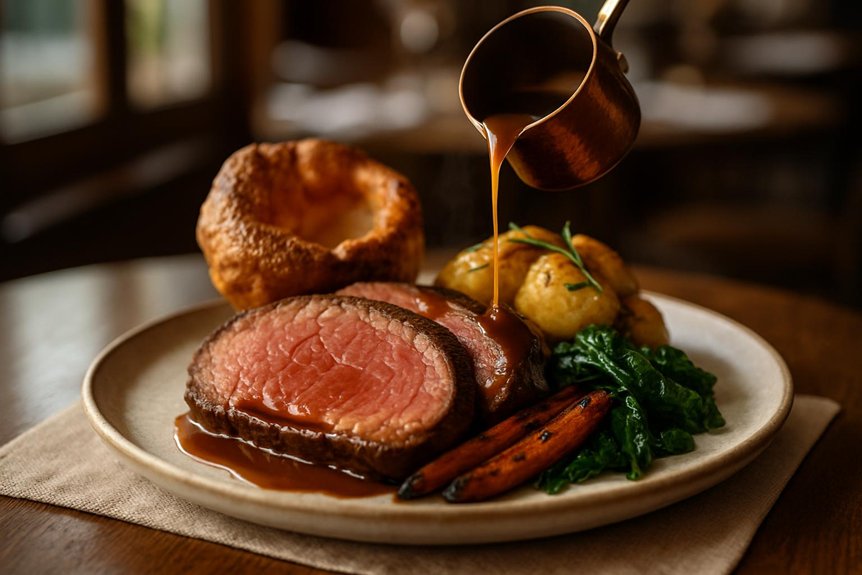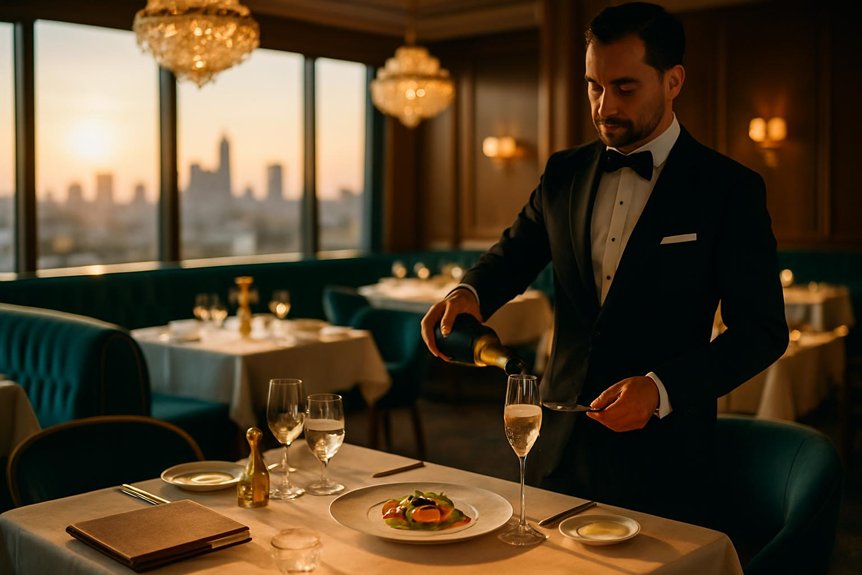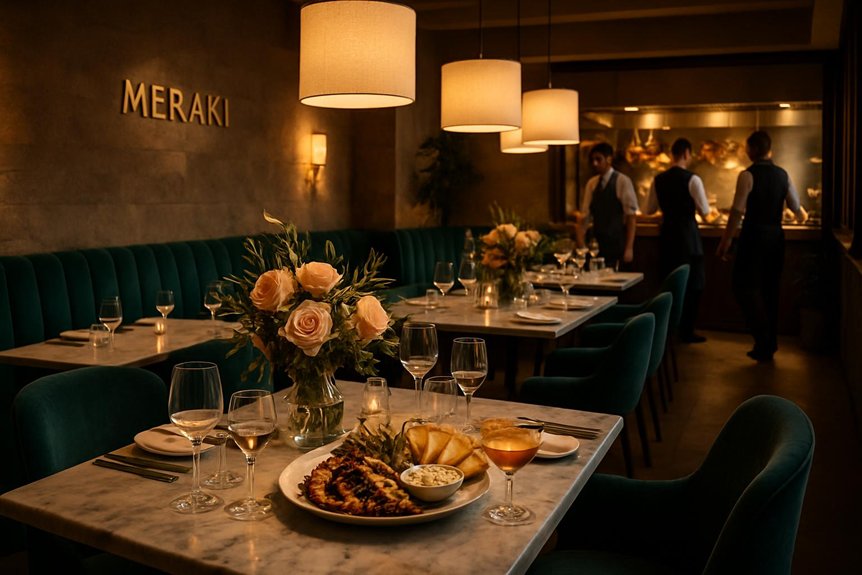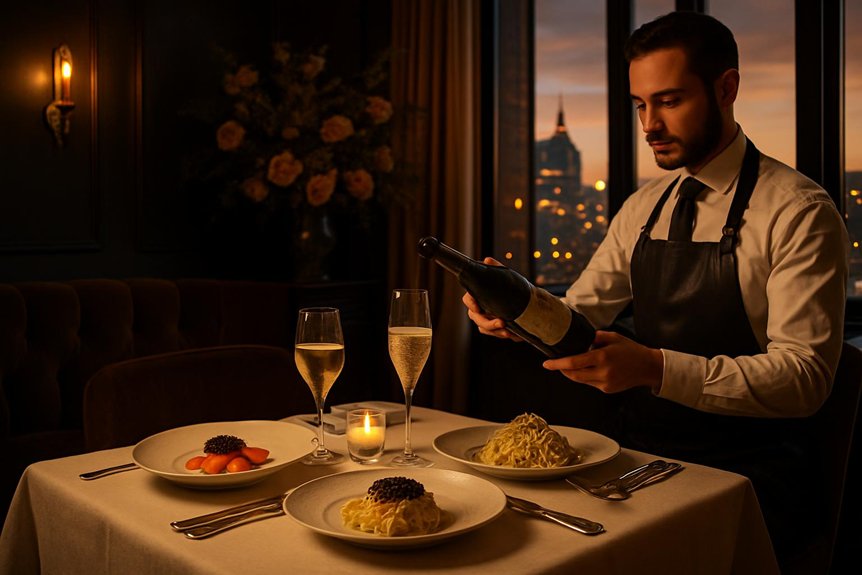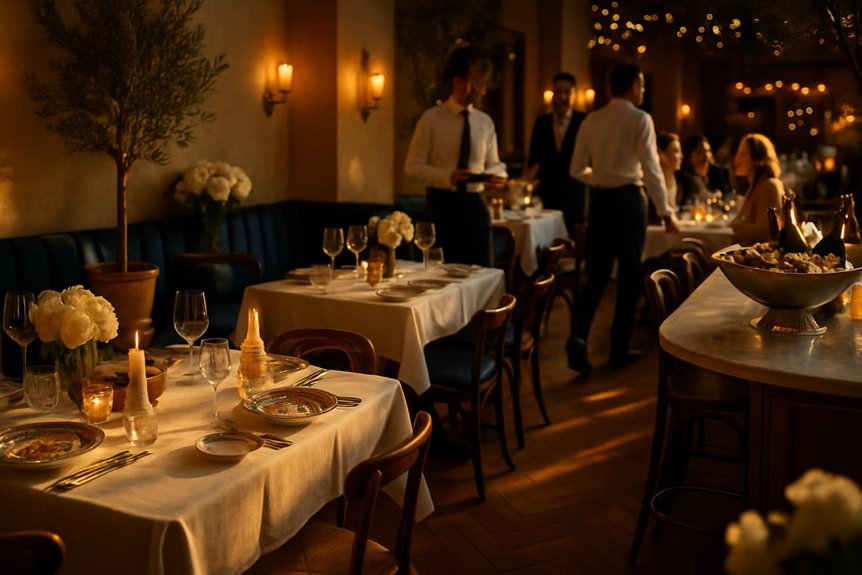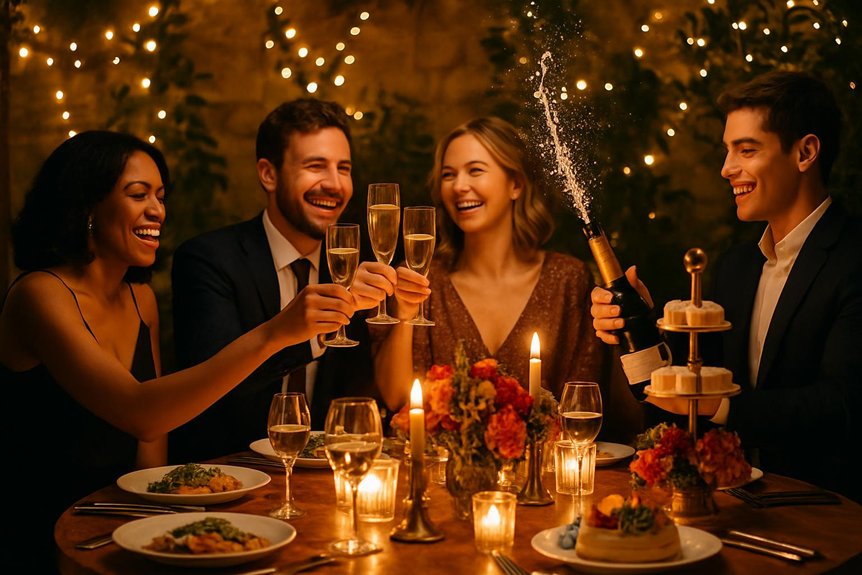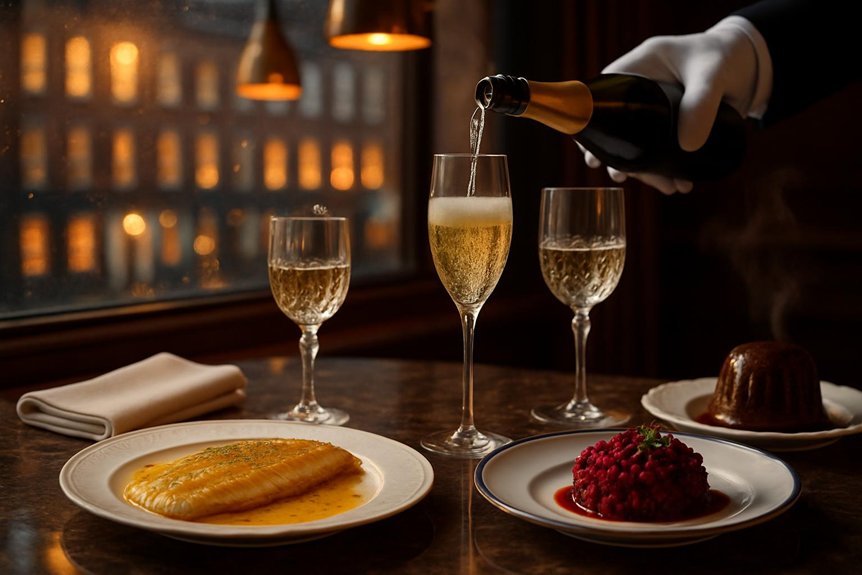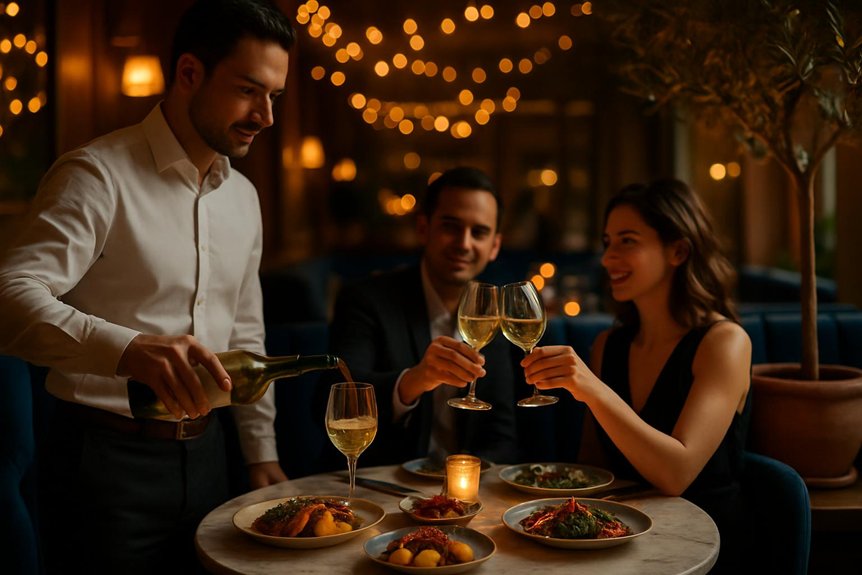London’s high-end dining scene balances precision and theater. Michelin-starred rooms showcase seasonal British produce shaped by global techniques. Chef’s counters whisper about limited seats and intricate courses. Wine lists read like atlases, while skyline dining rooms frame the city in glass. Service is polished, sometimes ritualistic. Caviar and truffle appear with intent, not excess. Sustainability guides sourcing as much as status. Yet the most interesting details begin where the reservation confirmation ends.
Michelin Masterpieces and Culinary Icons
Commanding global attention, London’s Michelin-starred restaurants showcase technical rigor, seasonal British produce, and cosmopolitan influences in equal measure. Precision-led kitchens reinterpret heritage ingredients—Orkney scallops, native beef, Kentish strawberries—through disciplined technique and restrained presentation.
Menus evolve with markets, while sommeliers map pairings that emphasize texture and minerality.
Dining rooms balance ceremony and ease. Restaurant decor favors tactile materials, warm lighting, and calibrated acoustics that frame the plate without distraction. Food photography thrives here: crisp compositions, controlled shadows, and color fidelity capture layered sauces, intricate garnishes, and architectural plating for digital audiences.
Service remains discreet, pacing courses with unforced rhythm. The result is a citywide benchmark where craftsmanship, sourcing, and visual narrative align, defining London’s contemporary fine-dining identity without showmanship or gimmickry. Meraki Bar and Living Room Bar launched for after-work drinks in London, adding to the city’s vibrant dining scene.
Chef’s Tables and Immersive Tasting Journeys
At London’s chef’s tables, guests sit inches from the pass, watching courses assembled with choreographed precision. These intimate counter experiences turn the kitchen into a stage, where technique, sourcing, and pacing are transparent. Multi-course tasting rituals then guide the evening’s arc, sequencing bold and subtle flavors into a cohesive narrative. For an alternative nightlife experience, consider visiting Meraki Restaurant, where you can enjoy dining, dancing, and vibrant vibes every Thursday to Saturday.
Intimate Counter Experiences
How better to understand a kitchen’s soul than from a front-row seat? In London, intimate counter experiences place guests inches from the pass, where technique, timing, and quiet theatre unfold without distraction. Unlike private dining behind closed doors, these seats deliver transparency: ingredients are introduced, heat is negotiated, and ideas evolve in real time through chef collaborations that refresh menus nightly. Conversation stays lean—focused on craft, provenance, and the final flourish.
1) Anticipation: the hush before a torch touches fish skin, the decisive slice, the plated shimmer that signals readiness.
2) Connection: eye contact with the brigade, unfiltered aromas, the cadence of pans marking each course’s arrival.
3) Memory: a signature bite recalled later by texture and temperature, anchoring the evening’s intimate momentum.
London boasts some of the best Greek restaurants where diners can experience innovative yet traditional cuisine, such as Kima’s fin-to-gill no-waste approach or Meraki’s soulful dishes.
Multi-Course Tasting Rituals
A multi-course tasting in London unfolds as a calibrated journey, each course sequenced to shape tempo, palate fatigue, and surprise. At chef’s tables, proximity clarifies intent: diners observe sourcing narratives, reductions ticking on the pass, and the choreography of final seasoning.
Immersive tasting journeys emphasize contrast—cool against warm, crisp after silken—using fusion techniques to refract British terroir through Japanese precision, French rigor, or West African heat.
Progression matters. Early bites set acidity and salinity; mid-courses expand umami; finales taper sweetness to reset. Plating artistry guides anticipation, translating architecture into appetite with negative space, color gradients, and precise garnish placement.
Beverage pairings—tea, sake, or minimal-intervention wines—modulate texture. Service cadence, lighting, and soundscapes sustain focus, letting technique recede while flavor speaks.
The Art of Seasonal and Sustainable Luxury
London’s top kitchens increasingly align luxury with seasonality, building menus around peak British produce.
Ethical sourcing—line-caught seafood, heritage breeds, regenerative farms—reframes premium ingredients as responsible choices.
Low-waste techniques, from whole-animal butchery to inventive use of trimmings, complete a model of refinement with restraint.
Sourcing With the Seasons
Why do the city’s most coveted tables turn to the calendar as their quiet maître d’? Because seasonality choreographs precision: chefs align ripeness with restraint, letting peak ingredients lead.
In London, menus pivot weekly—sometimes daily—guided by coastal landings, hedgerow finds, and the discreet science of urban fermentations that extend fleeting moments without masking terroir.
Artisanal foraging brings city and countryside into dialogue, translating fog, rain, and brittle sunlight into texture and tone.
- Anticipation: diners feel the first peas, the last greengages—an edible countdown that sharpens memory.
- Intimacy: producers are named, fields traced, tides counted, turning a plate into a map.
- Reverence: waste shrinks, flavors deepen, patience is rewarded—proof that luxury listens, not shouts, and time is the rarest seasoning.
Ethical Luxury Ingredients
From the cadence of seasons emerges a stricter standard: luxury measured not just by rarity, but by responsibility. In London’s refined dining rooms, chefs increasingly define prestige through provenance, traceability, and environmental stewardship. Ethical sourcing now frames the journey of prized ingredients—dayboat fish from well-managed waters, heritage grains cultivated through artisanal farming, and pasture-raised meats backed by transparent welfare certifications.
Caviar alternatives, single-origin chocolate from regenerative cooperatives, and biodiverse British cheeses exemplify this recalibrated indulgence. Menus highlight growers by name, signaling accountability and craft rather than mere scarcity.
Sommeliers mirror the approach with low-intervention producers who protect soil health and biodiversity. The result is a culinary language where luxury aligns with ecological balance, cultural respect, and long-term viability—rare tastes anchored by principled choices.
Low-Waste Fine Dining
In the city’s most exacting kitchens, low-waste fine dining turns constraint into craft, treating seasonality as both palette and discipline. Chefs harvest flavor from peels, stems, and bones, transforming trimmings into sauces, ferments, and stocks. Waste becomes repertoire; scarcity, an engine of invention. Menus shift with microseasons, reflecting farm to table logistics and London’s growing network of urban producers.
Cellars store glut as garums and vinegars; pastry counters sweeten with spent grains and fruit lees. Even tasting menus are vegan friendly without compromise, rooting luxury in restraint and terroir.
1) Anticipation: the quiet drama of a menu rewritten after dawn’s delivery.
2) Relief: a bill that reads lighter on the planet without dimming pleasure.
3) Awe: technique elevating leftovers into luminous courses.
Wine Temples and Stellar Pairings
Although London’s kitchens command headlines, its wine temples quietly define the city’s most exacting luxury. Sommeliers orchestrate meals with precision, drawing from deep Wine cellars where rare vintages sit beside progressive bottles from emerging regions. Listings read like cartographies: verticals of Bordeaux, grower Champagne, sake experiments, and low-intervention whites calibrated for texture.
Glass pairings are treated as narratives rather than supplements. A saline Manzanilla primes the palate; a taut English sparkling resets rhythm; an alpine Nebbiolo lifts the game’s richness without weight. Temperature control, stem choice, and decanting times are timed to the kitchen’s beats, ensuring each pour peaks with the dish.
Beyond spectacle, these programs educate, revealing terroir through cadence and restraint, and making the city’s grand dinners feel finely tuned and inevitable.
Skyline Views and Design-Forward Dining Rooms
Precision at the glass finds its counterpart in rooms engineered for spectacle. From elevational perches above the Thames to hushed eyries in City towers, London’s high-end dining spaces choreograph sightlines as carefully as service. Panoramas act as architecture: dusk pulls gradients across glass, while garden terraces extend the sensory field, softening steel with herbaceous edges. Chairs, lighting, and acoustics are tuned for calm; circulation guides a discreet theater.
Art installations punctuate volumes, reframing views and anchoring memory without crowding the plate.
1) Awe: Skyscrape horizons dissolve daily noise, replacing it with a steadying, horizon-to-heart exhale.
2) Intimacy: Corner banquettes cradle conversations beneath low-lit halos, city lights flickering like confidants.
3) Revelation: Elevated perspectives recast London’s map, pairing altitude with design intent to sharpen appetite and attention.
Modern British Produce With Global Technique
London’s top kitchens spotlight seasonal British terroir while borrowing techniques from Tokyo, Lima, and Copenhagen.
Chefs apply fermentation, binchotan grilling, and precision saucing to native shellfish, rare-breed meats, and heritage vegetables.
The result is provenance-driven tasting menus that map farms and fisheries as clearly as courses, uniting local character with global craft.
Seasonal Terroir Focus
How does a plate speak of place while drawing on techniques from far beyond these shores? In London’s high-end rooms, chefs let the city’s larder answer. They rely on local foragers for coastal herbs, hedgerow berries, and woodland mushrooms, then compose seasonal pairings that frame British provenance without blurring its edges.
Early spring might set Wye Valley asparagus against nutty rapeseed miso; autumn could marry roast grouse to pickled bilberries and charred leeks. The result is a dialogue between soil, climate, and restraint—quietly expressive, never ornate.
1) Anticipation: the first scent of wild garlic announces a fleeting season.
2) Awe: a single, perfect oyster tastes of tide, wind, and stone.
3) Reverence: a plate returns the diner to field paths and briny air.
Global Culinary Techniques
A modern British kitchen now treats provenance as anchor and technique as passport. Chefs apply global methods to native produce with disciplined intent, letting precision carry flavor across borders without diluting identity. Fusion techniques are deployed as frameworks, not gimmicks: tempura lightens Isle of Wight tomatoes, yakitori glazing elevates Suffolk quail, and nixtamalization unlocks deeper character in heritage grains.
Spice blending is equally exacting. British shellfish meets Kashmiri chile oil for calibrated heat; miso cures bring mineral depth to Cornish mackerel; vadouvan perfumes butter sauces without overpowering coastal sweetness. Fermentation, fire control, and low-temperature poaching translate international know-how into crisp textures and lucid tastes.
The result is a cosmopolitan lexicon applied to local ingredients, rigorous yet restrained, attentive to clarity of expression.
Provenance-Driven Tasting Menus
From technique as passport emerges a dining format that maps Britain’s fields, coasts, and dairies course by course. Chefs curate provenance-driven menus that spotlight artisanal ingredients with meticulous sourcing and minimal interference. Heritage beetroot, raw milk cheeses, native shellfish, and rare-breed meats meet precise fermentations, broths, and fires learned from worldwide kitchens.
Cultural influences sharpen rather than overshadow: a koji cure on chalk-stream trout, garum whispers in lamb jus, yuzu lifting orchard apples.
Each plate narrates landscape and season, but also labor—farmers, foragers, cheesemakers—rendered visible through restrained plating and calibrated textures.
Wine and low-intervention pairings trace similar maps, favoring maritime salinity, hedgerow bitterness, and meadow florals.
- Anticipation: the menu unfolds like a coastline at dawn.
- Wonder: terroir, clarified.
- Gratitude: craft honored.
The Rise of Luxe Counter Dining
Why has the white tablecloth yielded ground to marble counters and chef-side stools? In London, diners now seek proximity: heat from the plancha, the rhythm of plating, and conversations that illuminate farm to table sourcing and artisanal craft.
Counter formats compress distance between conception and consumption, turning service into a choreographed, intimate performance.
This shift also redefines luxury. Seats are limited, attention is personal, and timing is exacting. Chefs present micro-courses at peak, explaining techniques and seasonal choices while guests witness precision and restraint.
Design follows function—curved stone, tailored lighting, and acoustics calibrated for quiet exchanges. Reservations become prized theater tickets, yet the mood stays unfussy.
The result: elevated dining that favors engagement, tempo, and transparency over ceremony.
Caviar, Truffles, and Decadent Signatures
In that intimate orbit around the pass, indulgence takes a new shape: caviar spooned with clinical accuracy, truffles shaved to the gram, and signatures engineered for impact over opulence.
In London’s highest tiers, Luxury caviar becomes a lens for precision—pearls calibrated to salinity, fat, and temperature.
Truffle indulgence is treated like a variable, its perfume rationed to align with broth depth or dairy nuance.
Decadent signatures lean on restraint: a single, high-frequency flavor amplified by texture and contrast rather than bulk.
- Awe: the hush when a lacquered plate lands, black pearls glinting like Morse code.
- Tension: the blade’s whisper as white shavings fall, seconds before aroma blooms.
- Release: the bite where salinity, butter, and umami solve an elegant equation.
Service Rituals and Theatrics at the Table
Though plates carry the chef’s intent, it is choreography that fixes memory: linens snapped taut, cloches lifted in unison, sauces traced tableside with metronomic calm.
In London’s elite dining rooms, service reads like a score—precise pacing, synchronized steps, and hushed cues shaping anticipation as much as flavor. Gueridon trolleys wheel in, carving and flambé performed inches from crystal; aromas rise, flames bloom, and theatrical presentations turn technique into narrative.
Discretion remains central. Staff guide table etiquette without intrusion, aligning cutlery, resetting glassware, and timing pours to the cadence of conversation.
A quiet nod summons a sommelier; a gloved hand delivers a final flourish. The ritual underscores hospitality’s purpose: to make complexity feel effortless, and ceremony feel intimate rather than staged.
Reservations, Dress Codes, and Insider Tips
How far ahead should one plan for a coveted table? In London’s high-end scene, four to six weeks is common; marquee launches and chef’s counters disappear within minutes. Precision matters: monitor booking drops at midnight, set alerts, and be flexible with lunch or late seatings. Clear communication secures preferences and avoids last-minute forfeits.
Dress codes vary from smart-casual to formal; trainers and distressed denim can invite refusal. A jacket may be offered, yet polished choices signal respect and ease interactions. For cancellations, speed and courtesy preserve goodwill and future access.
- Anticipation: reservation tips that turn a waitlist into a seat, transforming hope into arrival.
- Poise: dress codes as quiet armor, amplifying confidence under chandeliers.
- Serendipity: a bar stool opening, and a night unexpectedly unforgettable.
Conclusion
Ultimately, London’s high-end dining proves less intimidating than it appears. Though some may worry about cost or formality, the city’s finest rooms increasingly offer flexible menus, welcoming service, and options like lunch tastings or counter seats that soften both price and tone. With seasonality at the core, thoughtful beverage pairings, and design that thrills as much as the cuisine, these experiences reward curiosity. Approach with openness, book smartly, and let craft, care, and surprise carry the evening.
